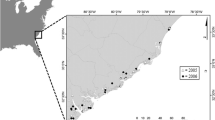Abstract
Factors affecting Kepone uptake and lipid content of the clam,Rangia cuneata, were tested over a 12 month study. Clams obtained from the Rappahannock and James Rivers were held in submersible liver boxes at two sites in the James River estuary and were sampled monthly from September 1978 through August 1979. Clams held in the freshwater zone near the source of Kepone contamination (Hopewell, Virginia) generally had higher Kepone and lipid content than those held downstream in the oligohaline zone. Significant differences in Kepone content between test sites and months are largely, but not entirely, a function of ambient water temperature, dissolved oxygen, amount of lipid in the clam, turbidity, Kepone content of the water column and duration of exposure. Lipid content of clams varied significantly between test sites, river of origin and months and is significantly related to salinity, ambient water temperature, pH and duration of exposure. Kepone content was more closely correlated with total lipid stores of clams than any other real variable. This association may be due to lipid reserves acting as a storage site for Kepone, but may also be interpreted as the result of selection against clams lacking lipid stores that might act as reservoirs for Kepone thus protecting more delicate tissues.
Similar content being viewed by others
Literature Cited
Bahner, L. H., A. J. Wilson, Jr.,J. M. Sheppard, J. M. Patrick, Jr.,L. R. Goodman, andG. E. Walsh. 1977. Kepone® bioconcentration, accumulation, loss and transfer through estuarine food chains.Chesapeake Sci. 18:299–308.
Battelle Memorial Institute. 1978. The feasibility of mitigating Kepone contamination in the James River Basin (Appendix A to the EPA Kepone Mitigation Project Report). Pacific Northwest Laboratory, Richland, Washington.
Bender, M. E., R. J. Huggett, and W. J. Hargis, Jr. 1977. Kepone® residues in Chesapeake Bay biota. Proceedings of the Kepone Seminar II, September 20–21, Easton, Md.
Cain, T. D. 1975. Reproduction and recruitment of the brackish water clamRangia cuneata in the James River, Virginia.Fish. Bull. 73:412–430.
Commonwealth of Virginia, Division of Consolidated Laboratory Services. 1979a. Chlordecone (Kepone®) mirex in metabolites in fish and shellfish. Tech. Proc. 3–126. Richmond, Va.
Commonwealth of Virginia, Division of Consolidated Laboratory Services. 1979b. Determination of chlordecone (Kepone®) in water. Tech. Proc. 3–122. Richmond, Va.
Fabacher, D. L., andH. Chambers. 1971. A possible mechanism of insecticide resistance in mosquitofish.Bull. Environ. Contam. Toxicol. 6:372–376.
Fairbanks, L. D. 1963. biodemographic studies of the clamRangia cuneata Gray.Tulane Stud. Zool. 10:3–47.
Huggett, R. J. 1977. Uptake of Kepone from suspended sediments by oysters,Rangia, andMacoma.In Kepone in the Marine Environment, Publications and Prepublications. U.S. Environmental Protection Agency, Environmental Research Laboratory, Sabine Island, Gulf Breeze, Fla.
Jordan, R. A., P. A. Goodwin, C. E. Sutton, V. J. Lascara, P. A. Van Veld, and R. K. Carpenter. 1979. An evaluation of the Kepone contamination of the plankton of the James River. Final technical report to the EPA. Va. Institute of Marine Science.
Koenig, C. C., R. J. Livingston, andC. R. Cripe. 1976. Blue crab mortality: interaction of temperature and DDT residues.Arch. Environ. Contam. Toxicol. 4:119–128.
Lunsford, C. A., C. L. Walton, and J. W. Shell. 1980. Summary of Kepone study results—1976–1978. Va. State Water Control Board. Basic Data Bull. No. 46, 86 p.
Macek, K. J., C. Hutchinson, andO. B. Cope. 1969. The effects of temperature on the susceptibility of bluegills and rainbow trout to selected pesticides.Bull. Environ. Contam. Toxicol. 4:174–183.
Nichols, M. M., andR. C. Trotman. 1977. Kepone in the James River sediments, an annual progress report to EPA.In Kepone in the Marine Environment, Publications and Prepublications, U.S. Environmental Protection Agency, Environmental Research Laboratory, Sabine Island, Gulf Breeze, Fla.
Tenore, K. R., D. B. Horton, andT. W. Duke. 1968. Effects of bottom substrate on the brackish water bivalveRangia cuneata.Chesapeake Sci. 9:238–248.
Zar, J. H. 1973. Using regression techniques for prediction in homeotherm bioenergetics, p. 115–133.In J. A. Gessaman (ed.), Ecological Energetics of Homeotherms: A View Compatible with Ecological Modeling. Utah State Univ. Press, Logan, Utah.
Zar, J. H. 1974. Biostatistical analysis. Prentice-Hall, N.J.
Author information
Authors and Affiliations
Additional information
Registered trademark for decachlorooctahydro-1, 3,3-metheno-2H-Cyclobuta (cd) pentalen-2 one. Allied Chemical Co., 40 Rector St., New York.
Rights and permissions
About this article
Cite this article
Lunsford, C.A., Blem, C.R. Annual cycle of kepone® residue and lipid content of the estuarine clam,Rangia cuneata . Estuaries 5, 121–130 (1982). https://doi.org/10.2307/1352109
Issue Date:
DOI: https://doi.org/10.2307/1352109




